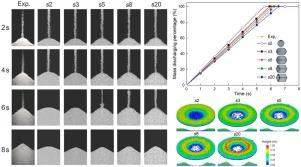Reliability study of super-ellipsoid DEM in representing the packing structure of blast furnace |
| |
| Affiliation: | 1. Institute of Chemistry, Federal University of Goiás - UFG, Campus Samambaia, Goiânia, GO, 74690-900, Brazil;2. School of Chemical Engineering, Federal University of Uberlândia - UFU, Campus Santa Mônica, Uberlândia, MG, 38408-144, Brazil;1. Department of Civil and Environmental Engineering, Universidad de los Andes, Carrera 1Este #19A-40, Bogota, Colombia;2. Department of Chemical Engineering, University of the Basque Country, Barrio Sarriena s/n, Leioa, Spain;1. School of Chemical Engineering and Technology, Tianjin University, Tianjin 300072, China;2. Department of Chemical & Biochemical Engineering, Western University, London, Ontario N6A 3K7, Canada;3. Institute of Shaoxing, Tianjin University, Zhejiang 312300, China;1. Polatlı Science and Literature Faculty, Nanosan Laboratory, Ankara Hacı Bayram Veli University, Ankara 06900, Turkey;2. Advanced Technologies Application and Research Center, Hacettepe University, Ankara 06900, Turkey;3. Science and Literature Faculty, Biology Department, Marmara University, Istanbul 34722, Turkey |
| |
| Abstract: | 
In industrial blast furnaces (BFs), the investigations involving the flow behaviors of particles and the resultant burden structure are essential to optimize its operation stability and energy consumption. With the advance of computing capability and mathematical model, the discrete element method (DEM) specialized in characterizing particle behavior has manifested its power in the investigation of BFs. In the framework of DEM, many particle models have been developed, but which model is more suitable for simulating the particle behaviors of BFs remains a question because real particles in BFs have large shape and size dispersity. Among these particle models, the super-ellipsoid model possesses the ability to change shape flexibly. Therefore, the focus of this study is to investigate whether the super-ellipsoid model can meet the requirement of authenticity and accuracy in simulating the behaviors of particles with large shape and size dispersity. To answer this question, a simplified BF charging system composed of a hopper and a storage bin is established. The charging process and the final packing structure are analyzed and compared between experiments and simulations with different shape indexes. The results show that super-ellipsoid particles have prominent advantages over spherical particles in terms of representing the real BF particles, and it can more reasonably reproduce the flow behaviors and packing structure of experimental particles. The computation cost of super-ellipsoid particles is also acceptable for engineering applications. Finally, the micro-scale characteristics of packing structure is analyzed and the single-ring charging process in industry-scale BF using super-ellipsoid particles is conducted. |
| |
| Keywords: | Blast furnace Discrete element method (DEM) Super-ellipsoid model Non-spherical particle Packing structure |
| 本文献已被 ScienceDirect 等数据库收录! |
|

